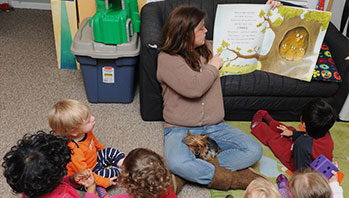- chart paper
- marker
- "We Are All Scientists" chart
- explore
- observe
- scientist
MA Standards:
Reading for Informational Text/RI.P.MA.1: With prompting and support, ask and answer questions about an informational text read aloud.
Reading for Informational Text/RI.P.MA.6: With prompting and support, “read” illustrations in an informational picture book by describing facts learned from the pictures.
Reading for Informational Text/RI.P.MA.10: Listen actively as an individual and as a member of a group to a variety of age-appropriate informational texts read aloud.
Head Start Outcomes:
Logic & Reasoning/Problem Solving 4: Uses past knowledge to build new knowledge.
Language Development/Receptive Language: Comprehends increasingly complex and varied vocabulary.
Language Development/Expressive Language: Uses increasingly complex and varied vocabulary.
Literacy Knowledge/Book Appreciation & Knowledge: Shows interest in shared reading experiences and looking at books independently.
Literacy Knowledge/Book Appreciation & Knowledge: Asks and answers questions and makes comments about print materials.
Science Knowledge/Scientific Skills & Method: Describes and discusses predictions, explanations, and generalizations based on past experience.
PreK Learning Guidelines:
English Language Arts/Reading and Literature 6: Listen to a wide variety of age appropriate literature read aloud.
English Language Arts/Reading and Literature 10: Engage actively in read-aloud activities by asking questions, offering ideas, predicting or retelling important parts of a story or informational book.
English Language Arts/Reading and Literature 13: Relate themes and information in books to personal experiences.
Read Together: What Is a Scientist?

© Commonwealth of Massachusetts, Department of Early Education and Care (Jennifer Waddell photographer). All rights reserved.
Tell children you are going to read What Is a Scientist? by Barbara Lehn, a book about some of the skills scientists use every day. Review the "We Are All Scientists" chart.
Before You Read
Show children the book cover. Ask children whether or not they think the girl on the cover is a scientist. Then have children identify things they see in the cover photograph (marker, jar, liquid in the jar). Have them describe what they think the girl is doing with the materials. Say, Let's find out what the girl is doing with these materials.
As You Read
Pause on the page that shows the girl from the cover photograph.
- Read the words “A scientist draws what she sees.” Slowly read as you point to each word.
- Point out how children used the same skill as they recorded what they observed outdoors.
After You Read
Discuss the things children in the book do that are the same things scientists do when they are exploring the world.
Do a picture walk through the book. Discuss any pages that children seem drawn to. Then ask,
- Which of these things did we do today outside?
- Which of these things did we do when we came inside to talk about our exploration?
Help children make connections between their exploration and the descriptions of scientific practices in the book.
